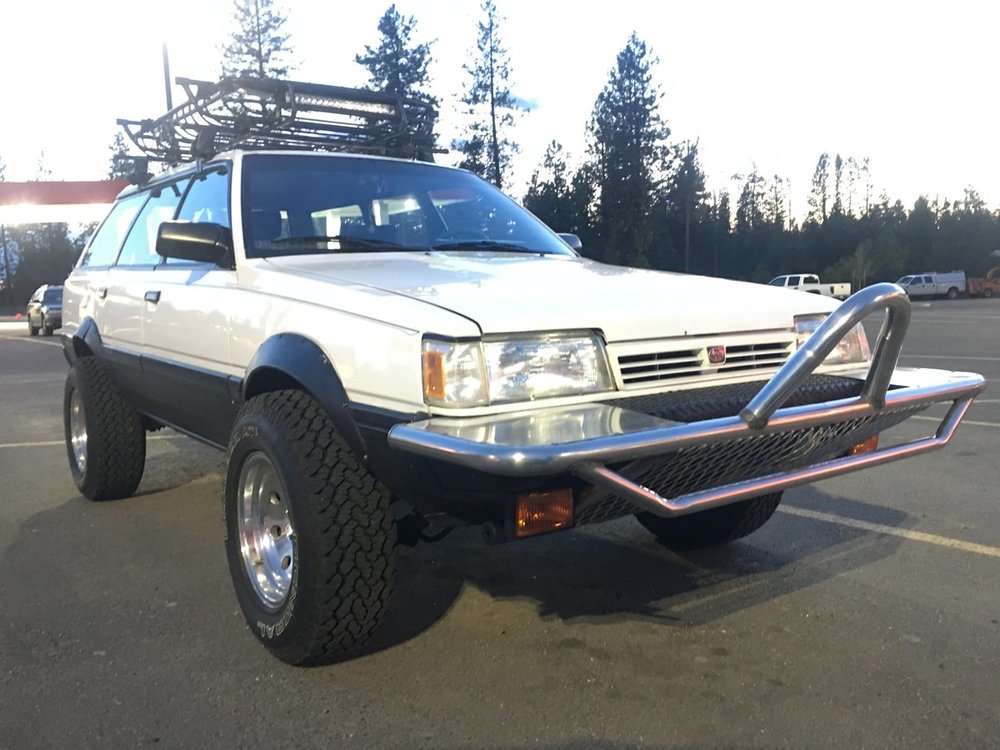Leaderboard
Popular Content
Showing content with the highest reputation on 01/15/19 in all areas
-
Ah great! Those EJ25's are almost as easy as they come. No special tools or tricks, super easy, i've done just the belt in under an hour so that's how easy access/labor is. Doing the job right requires more time than that though... Ideally you get Subaru or Aising timing kit - which includes the belt, 3 pulleys, tensioner, and water pump. The kit is only $200, it's an interference engine that usually bends lots of valves when one of those components fails. The lower sprocket and tensioner do fail and are not good high mileage/age items. If you're inclined to save a dollar - install a Subaru timing belt and the lower cogged idler, it is the part I've seen fail the most. And check the tensioner - if the seal is wet it should be replaced. Even if there's record of the "timing belt being done" - that doesn't mean much since it could be aftermarket and they usually don't replace the other components prone to failure. The original factory installed head gasket leaks on that year (symptoms vary by year) are always an external oil leak at the head/engine mating surface underneath the vehicle. it starts out really slow....just getting the metal wet, not even dripping, unnoticed unless you're staring at the bottom of your engine a lot, lol. This over time progresses to a drip and then more drips. It's rather benign. Keep checking the oil and you can drive them a long time with leaking headgaskets. They dont' blow in anyway that would strand you. But - of course a used car getting ditched for cheap can often have been run for awhile and already leaking. If it's leaking badly then you have the concern that someone ran it low on oil (as my friends daughter just did last week). Then the block is questionable....2 points
-
I've done 3 joints in the last year or so. One on an '04 Outback, and the other a '00 Outback. Process should be the same for basically all Subarus. We've tried used ones here, most of them have worn joints...not worth the install time IMHO.Dorman makes an aftermarket shaft, same part number for '96-'04 Outback AT. I fished a donor shaft out of the scrap bin here at work with bad joints that came from an '07 4EAT Outback. I've measured it, and held it up under my car, and it looks like it should work, at least temporarily (front half was hardest to measure, looks like it might be a hair short, but I'm not worried about the slip yoke having a little less engagement for street use for a week).Rockford offers joints specifically to replace the staked in applications. Here's their application list for the 430-10 part (the Justy is the only Subaru found elsewhere in their list).http://www.rockforddriveline.com/media/documents/Vehicle_Fitment_430-10.pdfYou may notice it lists Legacy/Outback 1990-2009.Using parts interchange listings, and trying other vehicles on that list, I came up with a few other part numbers. Napa lists a UJ10430, although there was no availability. Autozone lists a 2-0430DL, of which they had 4 in their Hub store across town. I now have 2 of those sitting on my desk (they are greasable, btw). 1. The joint before I started, you can see some of the 8 little "stakes" being deformations in the outer yoke holding the caps in. 20180827_192114 by Numbchux, on Flickr I've seen 2 ways to do staked in joints (generally, not specifically Subaru), one is to grind the stakes out, and the other is to just use a press to push through them. In my experimenting on other shafts, it takes an enormous amount of force (easily the most I've ever done on my little 12 ton HF press), so I opted to grind first. High speed metal cutting bit on the dremel does a pretty good work down in the corners. 20180827_192401 by Numbchux, on Flickr While I had it out, I used the dremel to make a few light marks on the yoke and the shaft itself to ensure the orientation when it came time to reassemble. 20180827_192552 by Numbchux, on Flickr 2. Then over to the press, make sure to support the other end of the shaft pretty well. 20180827_192748 by Numbchux, on Flickr 3. Once it's pressed off to one side, the stakes become really clear (some of these are ground down, some are un-touched). 20180827_192926 by Numbchux, on Flickr 4. Flip it over and press it back all the way through to flatten those stakes. Then lay it with the opposite yokes supported (a vice works best for this), and pound on the yoke so those cups can be pushed out beyond the ears. Don't pound on the thin part at the top of the ears, and don't pound on the shaft tubing itself. 20180827_193255 by Numbchux, on Flickr 5. Flip over and repeat the other way until those cups are pushed as far out of the yoke as possible. It should get to the point where the cross of the ujoint can be removed from the yoke (if those cups are damaged, you might need to sneak a punch passed the cross to push the cup out further, just make sure not to damage the yoke). 20180827_193408 by Numbchux, on Flickr 6. Then pound the cups out the rest of the way: 20180827_193515 by Numbchux, on Flickr Rotate the shaft 90*, and repeat steps 1-6 to remove the other 2 caps, and remove the joint completely. 7. Now switch to a softer dremel bit (wire wheel or sanding drum work well) to clean up the inside of the yoke, you want to smooth everything out without taking off really any material. You'll also want to run a flat file across the inner surface of those ears, as the new joints will be held in place by snaprings against this surface. 20180827_195537 by Numbchux, on Flickr 8. Now to start preparing the new joint. The four cups need to be removed from the center cross, inside those cups are needle bearings which have to stay in place, and the only thing holding them there is grease. They *should* be pregreased with assembly lube for this purpose, but I don't trust it, so I hold the caps in place by hand and gently pump some fresh grease through them: 20180827_194557 by Numbchux, on Flickr 9. Then pull the caps off. You'll notice I removed the grease zerk from the one cap to protect it from damage, this is optional, but IMHO a good idea. 20180827_194833 by Numbchux, on Flickr 10. Put the cross in the middle of the yoke, and one of the caps in from the outside. You want to hold the cross inside the cap as tight as possible as you press on it to help keep those needle bearings in place. 20180827_194903 by Numbchux, on Flickr 11. Then press it in well past it's final resting place. This simplifies putting on that snapring, and aligning the opposing cup. 20180827_201328 by Numbchux, on Flickr 12. Put the snapring on the one cup, then put the opposite cup from the other side, and again slide the cross into the new cup as you press it in. This is a bit tricky, as you have to get it pressed in far enough to get the second snapring on, but you don't want to put too much pressure on the bearings to damage them (although, the cross should bottom out in the cups before the needle bearings bear the brunt of the weight) Back to step 10 to finish the other half of the joint, taking care to reassemble in the same orientation that you started with. Install the grease zerk (if you removed it), and grease. 20180827_203215 by Numbchux, on Flickr Now flip the shaft and do it all again at the other end. Install in the car, and enjoy!1 point
-
you'll do fine generally speaking, there's a lower toothed idler that is often the weak spot - they seize or puke their bearings. 105k miles OR 105 months is the factory schedule. at 8.5 years but under 70K or so miles, my WRX's toothed idler was slightly wobbly, another idler was quite loose. Belts and most other (if OEM) parts are robust. the crank alignment mark for the install is a dash/groove on a timing lug at the rear of the sprocket - NOT the arrow/triangle at the front. That way, the pistons are at half-travel and no valve contact is possible.1 point
-
Thanks for the reply. I've done timing belts/chains on V6, V8 and I4 engines from both domestic and import manufacturers so if there's nothing really strange about these it shouldn't be a problem. I generally research a few discussion boards before diving into repairs on anything to get the general consensus on best techniques, shortcuts, and best parts to use.1 point
-
If it's cheap - then it probably has a head gasket leak. Summary - Check headgaskets, rust, and torque bind - drive in tight circles in a dry paved lot (steeering wheel turned to full lock right or left) and see if the car is "slowing down", or binding. And it'll need all new timing components. Details: Unless it's a really obvious situation like they just won a new car on The Price is Right, you should be skeptical of headgaskets on any legacy/outback, particularly if it's cheap and definitely if it's cheap and from a dealer. Rust is also a huge deterrent in your area - check the underneath like the rear suspension, brakes, and exhaust which could look like scrap metal. At 10+ years old and 150k it needs a new timing belt kit. It doesn't matter if the timing belt was replaced, the pulleys and tensioner can fail as well and should be replaced with an AISIN kit for approx. $250 plus labor. I have two 2008 and 2009 legacy's I'm getting rid of but if "value in terms of price" is your goal these won't be your ticket.1 point
-
I’d replace the igniter and the coil. A dead coil will kill the igniter. Ask me how I know... Cheers Bennie1 point
-
No one makes a harness. You have to pull one from a scrapped car. And the 90 to 94 stuff isn't worth having. Use a 95 or 96 harness, computer, and manifold. GD1 point
-
Using parts interchange listings, and trying other vehicles on that list, I came up with a few other part numbers. Napa lists a UJ10430, although there was no availability. Autozone lists a 2-0430DL, of which they had 4 in their Hub store across town. I now have 2 of those sitting on my desk (they are greasable, btw).1 point
-
1 point
-
What I did, was went to NAPA and got the two largest toggle switches, and the largest spring push button. I mouted then up under the left of the sterring wheel where that little "tray" is to put things. one switch runs the ignition, the other the accessorys, the push button starts the engine. I wasn't gunna pay the money for a new one. I love it. if some one does steel it it will take some time for them to figure it out. I do have the key so can lock the doors. hope that helps1 point
-
Both are FWD and am fine with keeping the car that way, it's just a commuter for when my Nissan is in pieces(A bi-monthly ritual it seems) I've been scouring and haven't seen much but will keep looking, probably just not looking the right areas! Sweet, that is all pretty reassuring. I wasn't aware they made 5 speeds for the EA81, pretty new to Subie's this old. I'll spend some time seeing if I can find any EA81 box's, though the EA82 box I'm looking at is tempting being 91K miles and relatively affordable Thank you both for your help!!1 point
-
Use the donut spare. Flip it around backwards if you need to. Drop or drive it on set of ramps. GD1 point
-
1 point







